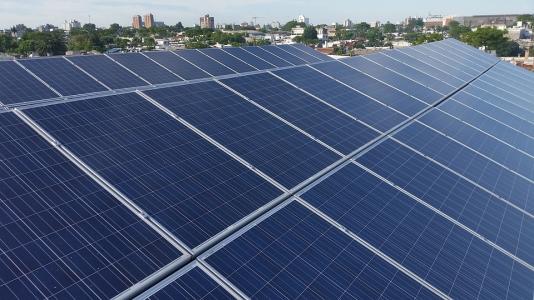Resources
Documents
Publications
Curriculum
Estimating the Benefits of Solar Projects
Rebates & Incentives
Photo: HELiOS Project
Documents
KyotoUSA Press Release and Agenda of November 7, 2011
Fresno Unified School District Solar Sampler
Publications
Below are several links to recent publications that provide a fairly comprehensive overview of the considerations and motivations for solar PV projects at public schools in California:
Brighter Future: A Study on Solar in U.S. Schools, 2nd Edition (2017) - This report intends to help K-12 schools understand the motivations and successes of current solar schools, provide insight into the basic technical and financing aspects of these systems, provide the most comprehesive baseline to date of K-12 schools with solar, and supply prospective solar school stakeholders with actionable information and lessons learned from previous projects so they can "go solar" with greater confidence.
Making the Grade with Clean Energy: Case Studies of California Solar Schools (2012) - This report presents case studies from 18 California school districts that have installed solar energy projects at nearly 200 schools combined, illustrating the environmental, economic and educational benefits of going solar in our schools. While not a comprehensive collection of all the schools that have invested in solar power in California, this report is a first-of-its-kind collection of success stories of public kindergarten through grade 12 (K-12) schools going solar.
A Blueprint For Environmental Literacy (2015) - Created by the California Environmental Literacy Task Force, the Blueprint For Environmental Literacy was made out of the belief that all California students should have access to quality environmental learning opportunities, which are a core component of their 21st century education. There are a growing number of resources available to guide teachers as they incorporate solar PV systems into their curriculum. See the Curriculum section below for more teaching resources.
One School’s Solar Project Fuels a Movement (2008) - KyotoUSA commissioned a study to estimate the benefits (e.g., economic, environmental, and health) that accrue to the community from the PV system installed at Washington Elementary School in Berkeley. The benefits described in the study supplement the obvious economic benefits that a school district realizes when it produces its own electricity.
Schools of the Future Report (2011) - This report produced by Superintentent of Public Instruction, Tom Torlakson, and a task force of experts in school housing, provides an overview of what is needed to make California's 10,000 schools the most efficient in the nation.
Curriculum
There is an abundance of resources available for solar energy curriculum through nonprofits and government agencies in the US. The benefits, regulations, and utility issues related to solar panels, as well as curriculum standards, vary among the states. Because of the popularity of solar PV systems in our sunny state, there are many California-specific resources available. Below are links to some helpful external sites.
Global Systems Science
There are many existing curriculum materials programs that easily benefit from onsite school solar energy systems as a unique STEM laboratory. There are examples of such programs developed at The Lawrence Hall of Science, UC Berkeley. Global Systems Science is such a curriculum for grades 9-12 that focuses on science-related societal issues and can support a 1- to 2-year integrated science course or supplement existing biology, physics, chemistry, Earth science, or environmental science courses.
PEAK
PEAK is a comprehensive, California Standards-based educational program designed to empower students to become smart energy managers in their homes, schools, and communities. The online and printed resources, training programs, and events are geared towards 3rd-7th grade teachers and students. Funding support comes in part from utility customers in California, and the program is administered under the auspices of the California Public Utilities Commission. Since 2006, PEAK has reached more than 40,000 students in over 100 school districts in various counties throughout California.
Solar Schoolhouse
Solar Schoolhouse’s mission is to provide students with the opportunity to experience the power of solar photovoltaics. Based in the San Francisco Bay Area, Solar Schoolhouse offers frequent teacher trainings, workshops, and film screenings, and also participates in solar-technology-related events in Northern and Southern California.
Rising Sun Energy Center
Provides direct energy- and water-use efficiency services and education, including solar education workshops for educators. It also offers several job training and employment programs for youth and adults.
National Energy Education Development (NEED) Project
Resources for educators and students related to a wide variety of energy topics: curriculum resources are tailored for individual state education requirements. The organization also hosts workshops for teachers and organizes the annual National Energy Conference for Educators. Student resources range from tips for science fair projects to the annual NEED Youth Energy Leadership Award.
U.S. Department of Energy
The Department of Energy offers clean energy education resources for teachers, students, and school administrators, including videos, data tools, lessons, and activities for educators at all levels, as well as information about professional development, including competitions, internships, and career planning tools. The Department of Energy also curates a YouTube channel with informational videos on the fundamentals of renewable energy technology and energy efficiency concepts. Resources are also available in Spanish.
Photo: bayernwelle.de
Estimating the Benefits of Solar Projects
The Jobs, Emissions, and Health Calculator can help you estimate and quantify the many benefits of your solar PV project, including:
1. The number of jobs a local PV project will support;
2. The amount of money that will remain in the community where the PV project is installed;
3. The health benefits that are generated - especialy for those people living in areas where electrcity plants are located; and
4. The amount of greenhouse gases and other toxic air pollutants avoided by producing electricity from the Sun!
Rebates & Incentives
1. One of the best state programs for publicly funded K-12 schools is the California Energy Commission's Bright Schools program. Districts can receive support (up to $20K) for energy audits, and get proposals, designs, and equipment bid specs reviewed by CEC specialists and consultants. Bright Schools will also introduce districts to the CEC's Energy Efficiency Financing program which offers very low interest loans for energy efficiency improvements and solar installations. In October 2012, the CEC began offering 0% and 1% interest rate loans (up to $3M per district) for public schools interested in improving energy efficiencies and installing renewable energy systems. At 1% interest it may be possible to install a PV system and pay for it entirely from energy savings. Please contact us if you would like to learn more.
2. Check out the Database for State Incentives for Renewable Energy (DSIRE). DSIRE is a comprehensive source of information on state, federal, local, and utility incentives and policies that support renewable energy and energy efficiency.
Note: The financing that is available to school districts and other PV purchasers is constantly evolving. We will do our best to keep this information as current and accurate as we can so that it can be a useful source of information. Nevertheless, we cannot assume any responsibility for how you use this information. Please be sure to do your homework prior to entering into any agreements for PV systems or Power Purchase Agreements.



